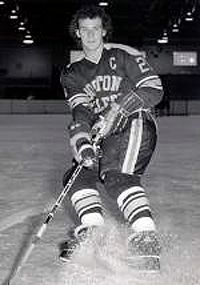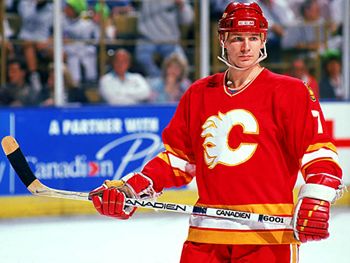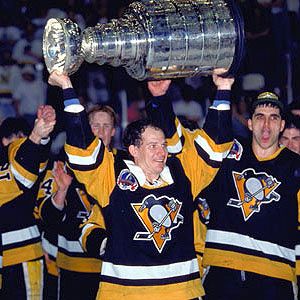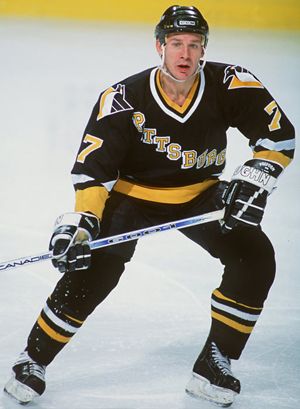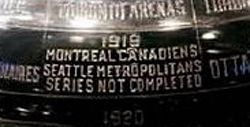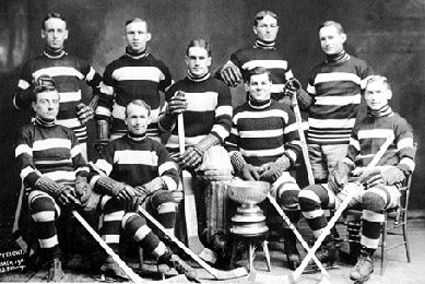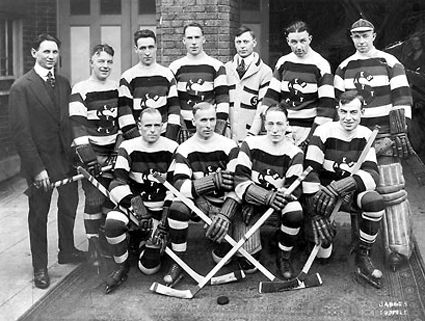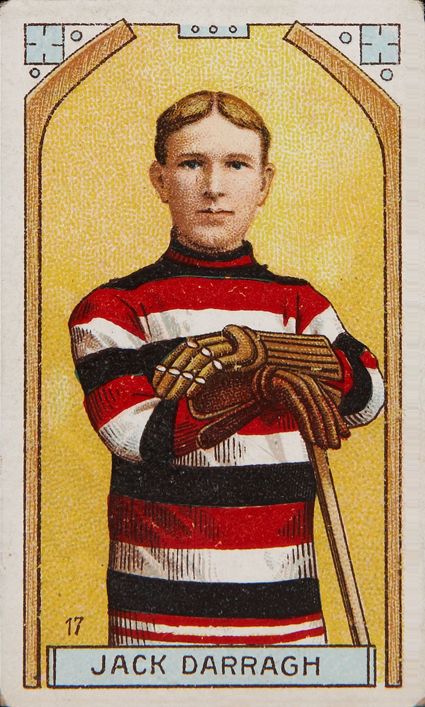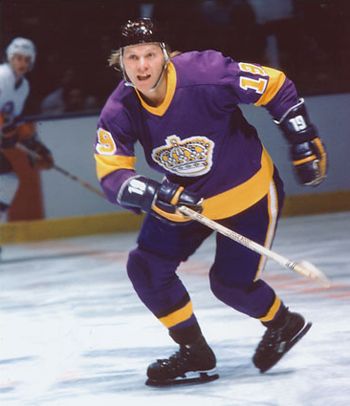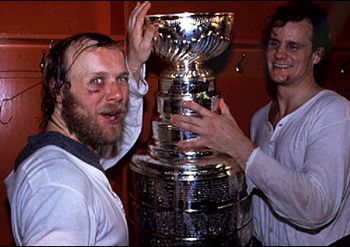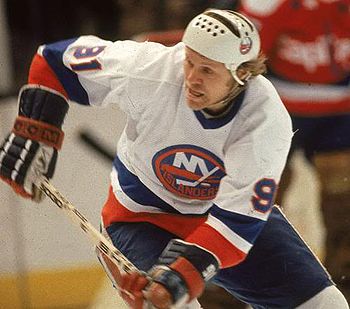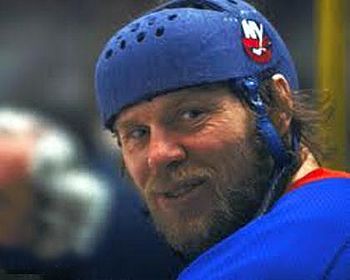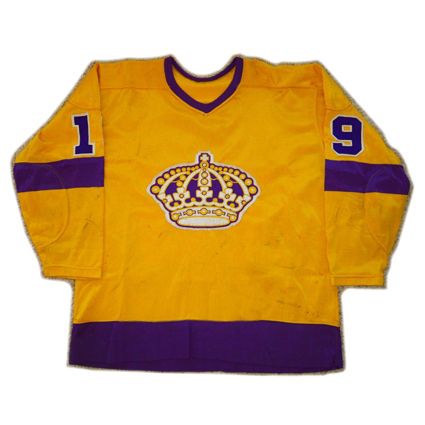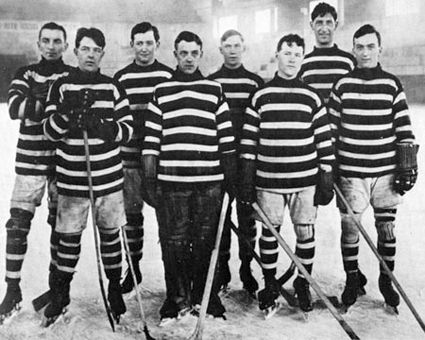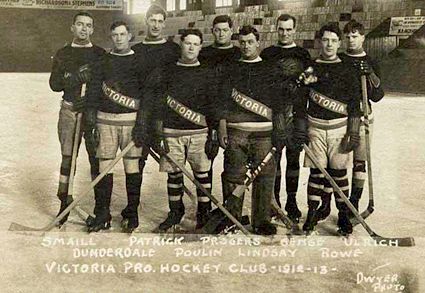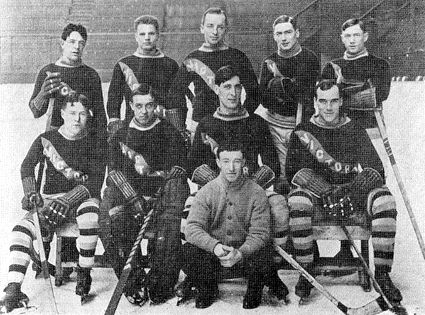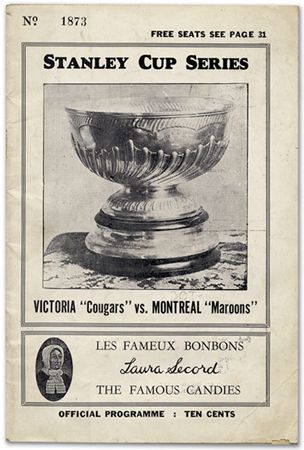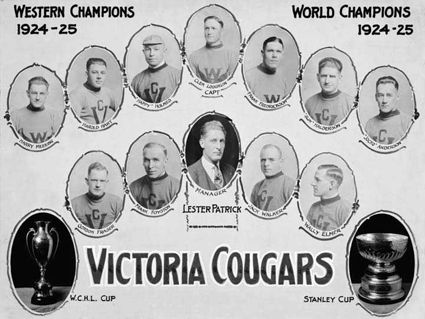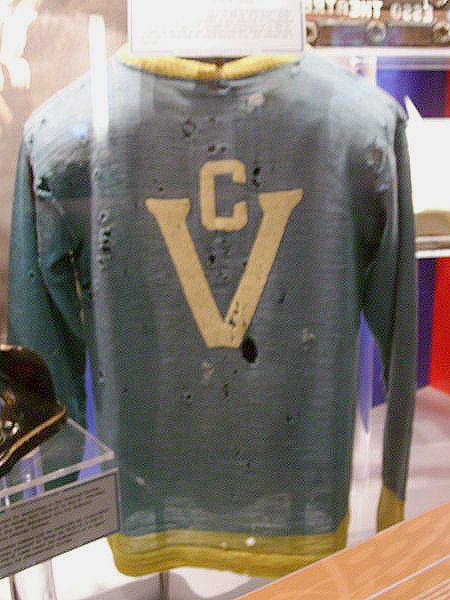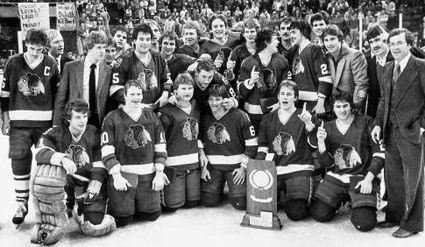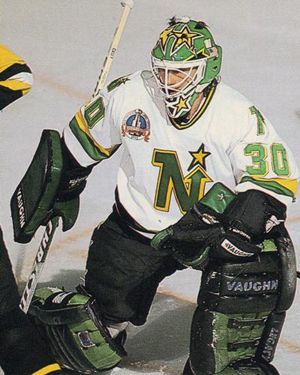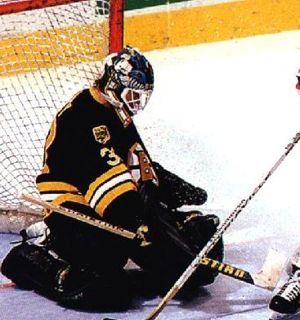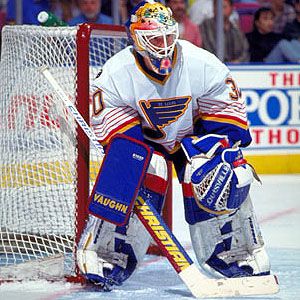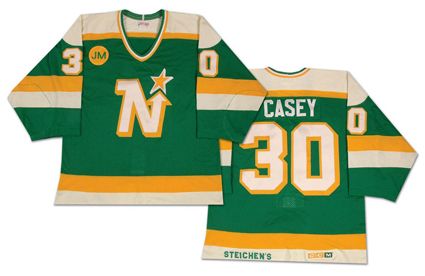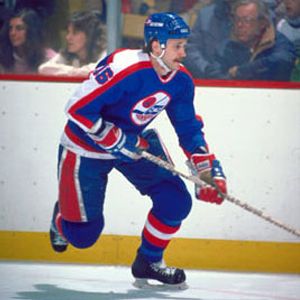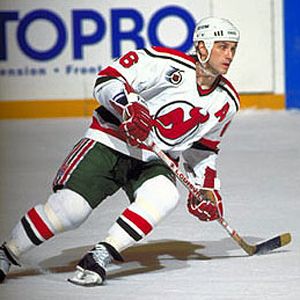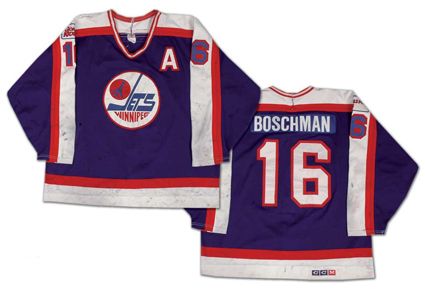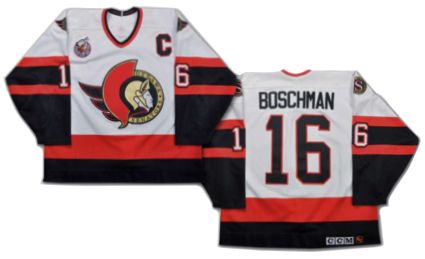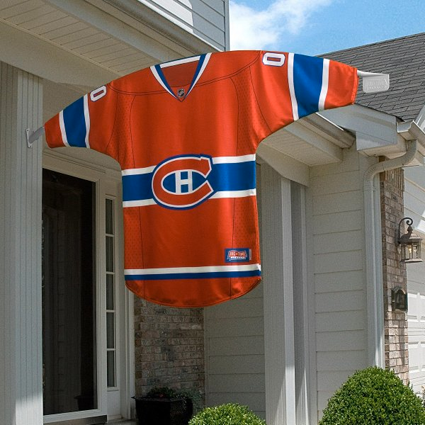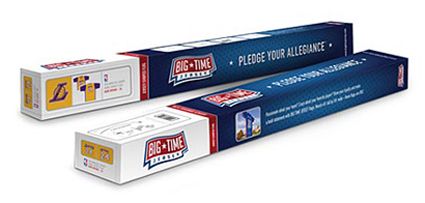Saturday, April 2, 2011
1988-89 Calgary Flames Joe Mullen Jersey
Joe Mullen, one of the best kept secrets in hockey history, attended Boston College for four years and, after finishing his college career, immediately played for the United States in the 1979 World Championships where he scored seven goals in eight games.
Boston College Eagles captain Joe Mullen
Rather than playing for the United States at the 1980 Olympics, Mullen turned professional when he signed a contract with the St. Louis Blues due to his father's illness and subsequent financial needs of the family, causing him to miss being a part of the "Miracle on Ice".
St. Louis assigned Mullen to the Salt Lake Golden Eagles of the CHL, where he was named the league's Rookie of the Year. The following season with the Golden Eagles, he would win the league scoring title.
In 1981-82 Mullen would see 45 games in the NHL and score 59 points. After another partial season in 1982-83, Mullen would stick full time with the Blues and rewarded them with his first 40 goal season, scoring 41 goals and 85 points. The next season would see another 40 goals and hit 92 points.
Inexplicably, St. Louis would trade Mullen halfway through the 1985-86 season, along with Terry Johnson and Rik Wilson to the Calgary Flames for Ed Beers, Charles Bourgeois and Gino Cavallini.
Not breaking stride, Mullen would total a career high 44 goals that season split between the two clubs. He would top that with 47 goals the next season as he led the Flames in scoring with 87 points, along with winning the Lady Byng Trophy, and 40 more goals the year after. The Flames would put it all together in 1988-89, as Mullen would score a career high 51 goals, along with 59 assists for a career best 110 points and his second Lady Byng Trophy.
Following a remarkable game in Flames history on March 21, 1989, Mullen celebrates his 50th goal of the season, as does Joe Nieuwendyk, while Lanny McDonald smiles after reaching both 500 goals and 1,000 points, all during the same game
During the final game of the season, played on this date in 1989, Mullen scored a goal and picked up a pair of assists in a 4-2 Flames win over the Edmonton Oilers. The three points Mullen scored that night set a new NHL record for most points in a season by an American born player, breaking the mark of 107 set by Jimmy Carson of the Los Angeles King the previous season.
Mullen and the Flames would finish the season by capturing the Stanley Cup after narrowly defeating the Vancouver Canucks in overtime of Game 7 in round 1 prior to sweeping the Kings in four and eliminating the Chicago Blackhawks in five before defeating the Montreal Canadiens in six games in the last Stanley Cup Final played between two Canadians teams, becoming the only team to ever win the cup against the Canadiens at the Montreal Forum in it's 71 year history.
After another 36 goal season in 1989-90, Mullen would be traded again, this time to the Pittsburgh Penguins prior to the 1990-91 season for a second round draft pick. The timing couldn't have been better for Mullen. Although he would only play in 47 regular season games due to injuries, his 17 points in 22 playoff games would help the Penguins capture their first Stanley Cup.
He would return to form with 42 goals in 1991-92 and Pittsburgh would again capture the Stanley Cup, the third of Mullen's career.
Two more 70 point seasons would follow before he was limited to 45 games in 1994-95 but did score the 1000th point of his career on February 7th in Pittsburgh, the 42nd player to reach 1000 points and the first American to do so.
He would sign as a free agent with the Boston Bruins for the 1995-96 season and play in 37 games, scoring 8 goals. After the season, Mullen would be named the 1995 winner of the Lester Patrick Trophy.
Mullen would return to Pittsburgh for his final NHL season. With just ten games remaining in the season, Mullen would score the 500th goal of his career, only the 25th player and first American to ever reach that hallowed milestone.
Internationally, despite missing out on the 1980 Olympics, Mullen would suit up for the United States during the 1984, 1987 and 1992 Canada Cup tournaments. After having retired from hockey in 1997, He would return one more time at age 42 to play for the United States in a qualifying tournament for the 1999 World Championships.
Mullen woud be inducted into the Hockey Hall of Fame in 2000.
Today's featured jersey is a 1988-89 Calgary Flames Joe Mullen jersey as he wore in when he became the highest scoring American-born player in NHL history at home against the Edmonton Oilers.
Calgary would continue to wear this style jersey through the 1993-94 season until it was replaced after 22 seasons of use, which included a change in logo after the franchise's relocation from Atlanta to Calgary.
With absolutely no highlights dedicated to Joe Mullen on youtube, the best we can offer are these videos of Mullen winning the Stanley Cup, first with the Calgary Flames in 1989 followed by the Penguins winning Game 6 to capture the 1991 Stanley Cup, which includes Mullen scoring a pair of the many Penguins goals and assisting on the one by Ron Francis.
Labels:
Calgary Flames,
Mullen Joe
Thursday, March 31, 2011
1919-20 Ottawa Senators Jack Darragh Jersey
At the conclusion of the 1918-19 hockey season, the Montreal Canadiens of the NHL travelled west to face off against the Seattle Metropolitans of the PCHA for the rights to the Stanley Cup Finals. With the series tied at 2-2-1, several members of the Canadiens began to show symptoms of the Spanish Influenza, which caused the remainder of the series to be cancelled and eventually claimed the life of Montreal's Joe Hall.
The 1919 Stanely Cup engraving which reads "series not completed"
One year later the NHL champion Ottawa Senators, who won both halves of the regular season to qualify for the finals without the need for the usual playoff. Meanwhile out west, the Metropolitans finished first overall in the PCHA by the slimmest of margins, as Seattle won 12 and lost 10 to narrowly edge the Vancouver Millionaires, who had a final record of 11-11-0, just ahead of the third place Victoria Aristocrats and their 10-12-0 mark.
Seattle still had to face Vancouver in a playoff series to determine the PCHA championship. Vancouver came out strong and won the first game by a 3-0 shutout only to have Seattle return the favor in spades, shutting out the Millionaires by a resounding 6-0 score to claim the series 6 goals to 3.
With their spot in the finals now secured, Seattle began the cross continent trek to the Canadian capital to face off against the Senators, who last drank from the cup back in 1911.
Before the clubs could take to the ice, there was a sartorial issue which needed to be resolved, as both the host Senators and the visiting Metropolitans wore "barberpole" style sweaters which featured colorful horizontal striping, the Senators in black, red and white, while Seattle arrived with their green, red and whites, forcing the Senators to agree to wear white sweaters to avoid any on ice confusion.
The Ottawa Senators in their black, red and white sweaters
The Seattle Metropolitans similar green, red and white sweaters
With their sweater clash now resolved, the Senators captured Game 1 on March 22nd when Jack Darragh scored the game winning goal to give Ottawa a hard fought 3-2 win.
Game 2 on March 24th also went the way of the Senators as goaltender Clint Benedict held the challengers from Seattle off the scoreboard with less than ideal ice conditions creating issues, but not enough to prevent Ottawa from scoring three times for the victory, with Darragh again getting credit for the game winning goal.
Three days later the Metropolitans fought back to make the series 2-1, but with the Senators still holding the advantage.
With milder temperatures in the capital compromising the quality of the ice at The Arena in Ottawa, which did not have the capability of producing artificial ice, officials conferred and a decision was reached to move the series to Arena Gardens in Toronto which was capable of producing it's own ice.
Seattle exploited the faster ice conditions for Game 4 on March 30 to even the series with a 5-2 win to force a deciding Game 5, which was held on this date in 1920. Darragh was the star of the night, as his hat trick, which once again included the game winning goal, powered the Senators to a 6-1 win to clinch the series 3 games to 2, returning the Stanley Cup to Ottawa where it has spent so much time during the century's first decade. Darragh finished the series second on goals scored with five, with three of them being game winning goals.
The 1920 Stanley Cup champion Ottawa Senators
The championship would begin the final era of Senators domination, as they would win the cup following season (191) and again in 1923 and 1927 for the fourth time in seven years before entering a period of financial decline which would see the club relocate to St. Louis by 1934.
Today's featured jersey is a 1919-20 Ottawa Senators Jack Darragh jersey in the familiar Senators barberpole style worn throughout their history.
After much searching, we were unable to locate any photos of the Senators from the 1920 Stanley Cup Finals wearing the white jerseys worn to avoid confusion with the Seattle Metropolitans similarly striped sweaters.
Darragh joined the Senators prior to them even becoming members of the NHL and would play 13 seasons with the club, winning Stanley Cups in 1911, 1920, 1921 and 1923. He had actually retired following their championship in 1921, but returned for after a season away from the team to play two more seasons, which included the championship in 1923. He finished his career with 194 goals in 250 games during his career and was elected to the Hockey Hall of Fame in 1962.
Today's video selection documents the early years of the Ottawa Senators and their Stanley Cup success with a focus on the arenas and their locations around Ottawa.
Labels:
Darragh Jack,
Ottawa Senators
1972-73 Los Angeles Kings Butch Goring Jersey
Drafted by the Los Angeles Kings in the 1969 NHL Amateur Draft, Butch Goring split his first two seasons between the Kings and their minor league affiliate, the Springfield Kings of the AHL. During his first season with Los Angeles Goring scored 13 goals and 36 points in 59 games and a whopping 8 penalty minutes, setting the tone for the remainder of his career.
In 1971-72, Goring became a full-time NHLer, playing 74 games exclusively with Los Angeles. He registered exactly 50 points that season and a mere 2 penalty minutes.
He bettered his point totals in 1972-73 when he set new personal bests with 28 goals and 31 assists for 59 points and, on this date in 1973 in the Kings final game of the season, Goring scored a goal and an assist, but more notably, he was whistled for his only penalty of the entire season midway through the game!
1973-74 saw Goring better his point total by 2 with 61 and again received but one penalty the whole season, his third consecutive season with but a single penalty.
Over the course of the next five seasons Goring would remain a model of consistency, playing in 398 out of a possible 400 games while setting new personal highs in points three times, finally topping out at 87 in 1978-79, a season in which Goring would "goon it up" with a career high 16 penalty minutes, one of only three times in 17 seasons he would reach double digits in minutes served in the penalty box.
Prior to setting his career point and penalty minute highs in 1979, Goring established a career best mark with 37 goals scored in 1977-78, a season in which he would also win the Masterton Trophy as well as a long overdue Lady Byng Trophy for gentlemanly play after being bypassed his previous six full seasons by players who had as many as 18 minutes in a season. Goring equalled a then career low with just 2 penalty minutes, the fourth time to date he would be whistled for just a single penalty during a season in which he played a minimum of 67 games.
Goring would play 69 games of the 1979-80 season with the Kings before being traded to the New York Islanders in March. He competed in the final 12 regular season games for New York and was regarded as a key element which put the Islanders over the top, as the club had made it as far as the playoff semifinals four times in the previous five seasons without having ever made it to the Stanley Cup Finals.
With Goring on board, the Islanders not only qualified for the finals for the first time ever, they successfully defeated the Philadelphia Flyers 4 games to 2 to capture the first of four consecutive Stanley Cups of the Islanders dynasty. The 21 playoff games Goring played during the 1980 playoffs compared to the 30 Goring had appeared in during his previous 10 seasons in Los Angeles and his 19 points during that playoff season eclipsed the 18 he had in all his years in Los Angeles combined.
The Islanders success following the acquisition of Goring is perhaps the one trade which began the current tradition of contending clubs looking to add key pieces to their roster in preparation for the playoffs that created the frenzy which the NHL trade deadline has now become.
During the final 12 regular season contests for New York, Goring received one penalty, which brought his career total in xx seasons up to 68, one more than the NHL single game record of 67 set by former Kings' teammate Randy Holt one year earlier.
In 1980-81, Goring played 78 games for the Islanders, scoring 60 points and competing the season without a single penalty for the only time in his career. Shockingly, Goring was passed over for the Lady Byng Trophy once more.
During the postseason, Goring scored 10 goals and 10 assists for 20 points in 18 games. While he came in fourth in playoff scoring for the Islanders, 15 points behind team leader Mike Bossy, Goring's tireless efforts and stellar two-way play were recognized with the Conn Smythe Trophy as the Islanders repeated as Stanley Cup champions, perhaps making up for the injustice of not receiving his much deserved Lady Byng Trophy.
Goring's role would switch more towards the defensive side over the remainder of his time in the NHL, as his point totals would drop from the 60-80 point range to the 30-45 range, but he remained an integral part of the Islanders, as they still had two more Stanley Cups to capture in 1982 and 1983.
He would play one more full season with the Islanders in 1983-84, which included a fifth consecutive trip to the Stanley Cup Finals, only to see their dynasty come to and end with the rise of Wayne Gretzky and the Edmonton Oilers dynasty of their own.
Goring's final NHL season began with 29 games with New York before he was released by the Islanders and picked up by the Boston Bruins, with whom he was a very effective player, scoring 34 points in 39 games, an average he had not achieved since his first season on Long Island.
The following season Goring was named the Bruins head coach, a position he held for all of the 1985-86 season and 13 games of 1986-87 before being relieved of his duties. Unusually, after losing his position as the Bruins coach, Goring returned to the ice as a player with the Nova Scotia Oilers of the AHL!
His stint with the Oilers lasted ten games and brought an end to his playing days. His final NHL totals were 1,107 games played, 375 goals and 513 assists for 888 points and 102 total penalty minutes over 16 seasons, a number which compares to the single season record of 472 by Dave Schultz and Tiger Williams career record of 3,996.
Despite his notable lack of penalty minutes, Goring is best remembered for wearing the same sPAPs brand helmet since he was 12 years old, famous for it's small size and lack of gloss while with the New York Islanders.
Goring actually had a pair of the helmets, one for at home and one for the road. They went through several color alterations as Goring moved from the Kings to the Islanders and later the Bruins and eventually the Nova Scotia to close out his career.
When Goring was traded from the Kings to New York, the Islanders equipment man didn't have the right color blue paint available and had to improvise while on the road to get Goring in line with the rest of the team, as his road helmet was currently painted Kings' purple while the other was painted gold. The solution was to cover one of the helmets with blue tape, giving the headgear it's distinctive flat appearance, as if it had been flocked.
"It looked pretty good, you couldn't tell the difference." Goring said. "The tape was light enough so it was no big deal, it did the job."
"I didn't wear it for the protection. It was almost why do you wear gloves, why do you wear pads? For me, it was like I didn't know any other way to play hockey other than with my helmet. I grew up in an era where helmets were mandatory as a kid and it just didn't make any sense to take it off because it wasn't anything cumbersome that I needed to get rid of."
"Hockey players are like any other athletes, they get attached to certain things and they had good success and the helmet for me and I actually had a couple of items I kept for a long period of time but I think it is just a comfort zone more than anything else," Goring recalled.
Today's featured jersey is a 1972-73 Los Angeles Kings Butch Goring jersey as worn the season Goring received his only penalty of the year halfway through the final game of the season.
The Kings began play in 1967 with gold jerseys with single color purple numbers, which became two color numbers in 1969-70 with the addition of white outlines, which was also added to the front crest at the same time. Names on the back of the gold jerseys would arrive in 1970-71. The following season the purple stripe on the gold jerseys would move down to the very bottom of the jersey, which would eliminate the gold stripe which previously existed beneath it. The Kings jerseys would exist in this configuration until being replaced after the 1979-80 season.
"I didn't wear it for the protection. It was almost why do you wear gloves, why do you wear pads? For me, it was like I didn't know any other way to play hockey other than with my helmet. I grew up in an era where helmets were mandatory as a kid and it just didn't make any sense to take it off because it wasn't anything cumbersome that I needed to get rid of."
"Hockey players are like any other athletes, they get attached to certain things and they had good success and the helmet for me and I actually had a couple of items I kept for a long period of time but I think it is just a comfort zone more than anything else," Goring recalled.
Today's featured jersey is a 1972-73 Los Angeles Kings Butch Goring jersey as worn the season Goring received his only penalty of the year halfway through the final game of the season.
The Kings began play in 1967 with gold jerseys with single color purple numbers, which became two color numbers in 1969-70 with the addition of white outlines, which was also added to the front crest at the same time. Names on the back of the gold jerseys would arrive in 1970-71. The following season the purple stripe on the gold jerseys would move down to the very bottom of the jersey, which would eliminate the gold stripe which previously existed beneath it. The Kings jerseys would exist in this configuration until being replaced after the 1979-80 season.
Today's video selection is the Islander celebrating their 1981 championship, which includes the presentation of the Conn Smythe Trophy to Butch Goring.
Labels:
Goring Butch,
Los Angeles Kings
Wednesday, March 30, 2011
1924-25 Victoria Cougars Jersey
The Victoria Cougars were formed in 1911 as the "Senators" as a member of the Pacific Coast Hockey Association (PCHA). Their first season in the three team PCHA saw them finish last with a 7-9 record behind the New Westminster Royals and the Vancouver Millionaires. They were led in scoring by Tommy Dunderdale's 24 goals in 16 games, good for third in the league.
The second season saw Victoria win the PCHA title with a 10-5 record. Dunderdale led both the club in scoring again but also the league this time with 24 goals and 29 points in 15 games. No other player had more than 14 goals, ten behind the prolific Dunderdale. Following the season the Senators defeated the National Hockey Association champion Quebec Bulldogs in an exhibition series
The 1911-12 Victoria Senators in their original barberpole sweaters
The second season saw Victoria win the PCHA title with a 10-5 record. Dunderdale led both the club in scoring again but also the league this time with 24 goals and 29 points in 15 games. No other player had more than 14 goals, ten behind the prolific Dunderdale. Following the season the Senators defeated the National Hockey Association champion Quebec Bulldogs in an exhibition series
The 1912-13 Victoria Senators Hockey Club
The club changed their name to the Aristocrats for the 1913-14 season and again won the PCHA title with an identical 10-5 record. They were led in scoring by Dubbie Kerr and his 20 goals and 31 points in 16 games followed by Dunderdale at 24 goals and 28 points. Now having established itself as a worthy league, the Aristocrats were able to travel to Toronto and challenge the Toronto Hockey Club (or Toronto Blueshirts) for the Stanley Cup, but came home without the cup.
After two more seasons as the Aristocrats, led in scoring by first Dunderdale and then Kerr, the club moved to Spokane, Washington where they were known as the Canaries for the 1916-17 season, but attendance was so poor that the team played their scheduled home games after mid February at the home rinks of their previously scheduled visitors!
The 1918-19 season saw the franchise back in Victoria as the Aristocrats once more and led in scoring by Eddie Oatman, who had come from the now defunct Portland Rosebuds, as had many of the Aristocrats that season.
1919-20 saw the 10-12 Aristocrats in third place with Dunderdale now returned to the fold and doing the bulk of the scoring with 26 goals and 33 points in the 22 game season to win the PCHA scoring title. Dunderdale had left Victoria following the 1914-15 season to play in Portland for three seasons, but was back with Victoria in 1918-19 when the Rosebuds player's contracts were transferred to the Aristocrats following the Rosebuds folding.
The Victoria Aristocrats during the 1914-15 season
After two more seasons as the Aristocrats, led in scoring by first Dunderdale and then Kerr, the club moved to Spokane, Washington where they were known as the Canaries for the 1916-17 season, but attendance was so poor that the team played their scheduled home games after mid February at the home rinks of their previously scheduled visitors!
The 1918-19 season saw the franchise back in Victoria as the Aristocrats once more and led in scoring by Eddie Oatman, who had come from the now defunct Portland Rosebuds, as had many of the Aristocrats that season.
1919-20 saw the 10-12 Aristocrats in third place with Dunderdale now returned to the fold and doing the bulk of the scoring with 26 goals and 33 points in the 22 game season to win the PCHA scoring title. Dunderdale had left Victoria following the 1914-15 season to play in Portland for three seasons, but was back with Victoria in 1918-19 when the Rosebuds player's contracts were transferred to the Aristocrats following the Rosebuds folding.
Another third place came in 1920-21 from a 10-13-1 mark. The Aristocrats' Frank Fredrickson led the PCHA in scoring with 20 goals and 12 assists for 32 points in 21 games.
The 1921-22 season saw the league standings decided by the narrowest of margins, with Seattle finishing first with a record of 12-11-1, the Millionares followed at 12-12-0 and the Aristocrats once more brought up the rear at 11-12-1. Fredrickson one more led the club with 25 points from 15 goals and 10 assists.
For the 1922-23 season, the franchise adopted the new moniker of the "Cougars" and it paid immediate dividends, as the club finally climbed out of last place for the first time. A 16-14-0 record was enough to beat the Metropolitans and qualify for the playoffs. Vancouver, newly renamed the Maroons, defeated the Cougars in a two-game total-goal series 3-0 and 2-3. Fredrickson again led the league in scoring with 39 goals and 55 points, 15 more than his next closest pursuer, in the 30 game schedule.
The final season for the PCHA saw the Cougars once more finish third with a record of 11-18-1. Fredrickson again led the club with 19 goals and 28 points in 30 games.
Changes were in store for the 1924-25 season, as the Cougars moved to the Western Canada Hockey League (WCHL), now in it's fourth season, along with the Vancouver Maroons. The Metropolitans had folded and the Cougars were awarded four players off their roster prior to the season and they selected goaltender Hap Holmes, Gordon Frasher, Jack Walker and Frank Foyston. While the Cougars finished third yet again, the WCHL was now a six team league, and the Cougars 32 points in the standings left them just behind the Calgary Tigers 34 and Saskatoon Sheiks 33. The prolific Fredrickson was the team leader in points for the fifth consecutive season with 22 goals and 30 points in 28 games.
The Cougars defeated the Shieks in their opening round two game series by a 6-4 total before upsetting the Tigers in the WCHL Finals in another two-game total-goal series by a combined score of 3-1 to earn the right to challenge the defending Stanley Cup winners and NHL champion Montreal Canadiens.
The finals were a best of five series and all games were played in British Columbia in keeping with the annual rotation of games between the east and the west. The Cougars took Game 1 with a score of 5-2 and put themselves in a position to capture the cup with a 3-1 win in Game 2 with Walker scoring a pair of goals in each game.
Montreal fought back with a 4-2 win on March 27th and the Cougars became the last team from outside the NHL to win the Stanley Cup with a dominant 6-1 win in Game 4 on this date in 1925, led by a pair of goals by Fredrickson to take the series 3 games to 1. The game winning goal was scored by Gizzy Hart and Walker led the Cougars with 4 goals in the series as the Cougars outscored Montreal 16-8.
Montreal fought back with a 4-2 win on March 27th and the Cougars became the last team from outside the NHL to win the Stanley Cup with a dominant 6-1 win in Game 4 on this date in 1925, led by a pair of goals by Fredrickson to take the series 3 games to 1. The game winning goal was scored by Gizzy Hart and Walker led the Cougars with 4 goals in the series as the Cougars outscored Montreal 16-8.
Their roster included Hall of Famers Fredrickson (inducted 1958), Foyston (1958), Walker (1960) and goaltender Holmes (1972) and they were coached by the legendary Lester Patrick (1947), who also owned the club. Additionally, Fredrickson and defenseman Harold Halderson were previously members of the Winnipeg Falcons who won the first Olympic gold medal in ice hockey.
The following season the WCHL was renamed the Western Hockey League (WHL) and the defending champion Cougars finished in their traditional third place yet again with a 15-11-4 mark. Fredrickson dominated the scoring with 24 points in 30 games to lead the team fir the sixth consecutive season. The Cougars again won the league playoffs to earn the right to face the NHL champion Montreal Maroons for the right to defend the cup, which the Maroons won 3 games to 1.
That would be the end of the Cougars in Victoria though, as the WHL disbanded after the season, leaving the Cougars without a league. The rights to most of their players were purchased by the new Detroit NHL franchise, which used the Cougars name as a tribute to the former club of the majority of their roster. Eventually that team would rename itself the Falcons and later the Red Wings.
Today's featured jersey is a 1924-25 Victoria Cougars Frank Frederickson jersey. This original Cougars jersey can be seen in the Hockey Hall of Fame in Toronto and has it's own page in The Hockey News Greatest Jerseys of All-Time Collector's Edition.
Today's video section is behind the scenes footage of the Hockey News Greatest Jerseys of All-Time photo shoot, which includes today's featured Victoria Cougars jersey. The Greatest Jerseys of All Time collector's edition is a must-have for any jersey collector or hockey fan alike.
Labels:
Victoria Aristocrats,
Victoria Cougars
Tuesday, March 29, 2011
1987-88 Minnesota North Stars Jon Casey Jersey
Born on this date in Grand Rapids, Minnesota in 1962, goaltender Jon Casey played college hockey for the University of North Dakota Fighting Sioux from 1980-81 until 1983-84, which included an appearance at the World Junior Tournament in 1982 for the United States and two NCAA national championships in 1980 and 1982.
Casey, front left, celebrates the 1982 NCAA national championship
Following his college career, the undrafted Casey would sign a free agent contract with the Minnesota North Stars in time for him to see action in two games at the conclusion of the 1983-84 season, which included his first NHL victory.
He spent the following season honing his craft with the Baltimore Skipjacks of the AHL, going 30-11-4 in 46 games. The following season was split between the Springfield Indians (9 games) and North Stars (26 games), with whom he went 11-11-1.
1986-87 saw Casey again spend the entire season in the minors, with both the Indians and the Indianapolis Checkers, where he spent the majority of his time. While he made 14 appearances with Minnesota in 1987-88, most of his action came with the Kalamazoo Wings of the IHL with whom he went 24-13-5.
The departure of Don Beaupre to Washington opened up a roster spot for Casey in Minnesota in 1988-89, who assumed the starting role with 55 games played, a total which increased to 61 the following year during which he set a career high with 31 victories. Following the NHL season, Casey made his only appearance at the World Championships, going 4-2 in six games.
The 1990-91 season saw Casey finish the season with 55 appearances and a 21-20-11 record, but come to life with a 14-7 mark in the playoffs as the North Stars made an improbable run to the Stanley Cup Finals after a posting a losing 27-39-14 record as a team during the regular season.
After two more seasons in Minnesota, making 52 then 60 appearances as well as playing in the 1993 NHL All-Star Game, Casey was traded to the Boston Bruins for the 1993-94 season where he was once more the starting goaltender with 57 appearances.
After his only season with the Bruins, Casey returned to the midwest by signing a free agent deal with the St. Louis Blues for 1994-95 to back up incumbent Curtis Joseph. After appearing in 19 games for St. Louis that season, Casey was limited to just 9 games in 1995-96 as he spent the majority of his time with the Peoria Rivermen of the IHL playing in 43 games.
His final NHL season saw him play 15 games for the Blues as well as 4 with the Worcester IceCats of the AHL. Casey would play one final season of professional hockey with the IHL's Kansas City Blades in 1997-98 prior to retiring in December of 1997 after 24 games with the Blades.
Casey's final NHL totals are 425 games played, 170 wins, 157 losses and 55 ties. He also posted 16 shutouts and a career goals against average of 3.21.
Today's featured jersey is a 1987-88 Minnesota North Stars Jon Casey jersey which features the "JM" patch worn in honor of John Mariucci, "The Godfather of American Hockey". Mariucci played for the University of Minnesota, five seasons for the Chicago Blackhawks, when American players in the NHL was a rarity, and then spent four more seasons playing in the various minor leagues of the day before retiring and entering the world of coaching.
Mariucci coached the University of Minnesota for 12 seasons with another spent as the coach of the US Olympic team, earning a silver medal in 1956. He would also coach Team USA at the 1976 and 1977 World Championships. The home of the Minnesota Golden Gophers, Mariucci Arena, is named for John and he is a member of the United States Hockey Hall of Fame and the Hockey Hall of Fame.
The North Stars adopted this style jersey for the 1978-79 season. This jersey would remain unchanged until 1988-89 with the addition of black to the striping pattern despite the white jerseys having black first added back in 1981, seven years earlier.
Labels:
Casey Jon,
Minnesota North Stars
Monday, March 28, 2011
1989-90 Winnipeg Jets Laurie Boschman Jersey
Following a stellar season with the Brandon Wheat Kings in which he scored 66 goals and 149 points as well as 215 penalty minutes, center Laurie Boschman was drafted 9th overall in the 1979 NHL Entry Draft by the Toronto Maple Leafs.
Boschman's first season in Toronto went well enough for an NHL rookie, as he played 80 games and scored 48 points, but year two was derailed by a bought of mononucleosis, from which he returned too quickly and lacked the necessary energy to compete at the NHL level as a result. Worse, he was criticized by the notoriously cantankerous Maple Leafs owner Harold Ballard for being too soft as a result of a religious conversion. Despite the "soft" accusations, Boschman racked up 178 penalty minutes in just 53 games that season.
A third abbreviated season in Toronto was cut short by a stomach ulcer before Boschman requested a trade and was dealt to the Edmonton Oilers in time for the final 11 games of the 1981-82 season, freeing him from Ballard's criticisms. After playing the majority of the 1982-83 season with the Oilers, Boschman was once again on the trading block due to the depth of the Oilers roster. He landed in Winnipeg with the Jets, a move which would fit him like a glove.
After playing four NHL seasons with a high of 48 points, his first full season with the Jets would see his production immediately increase to 74 points despite playing in just 61 games due to time missed with a separated shoulder. He would also total 234 penalty minutes, making him a true power forward.
The following season Boschman set a career high with 76 points, which included another career best of 32 goals, one of a record six Jets to score 30 or more goals. After scoring 69 points, along with a career high of 241 penalty minutes, Boschman's offensive production would decline somewhat as his season totals were in the 40's in 1987 and 1988 before 36 in 1989 and 27 in his final season in Winnipeg in 1989-90.
After eight stable years in Winnipeg, Boschman was sent to the New Jersey Devils where he would play for two seasons.
He was then left unprotected in the 1992 NHL Expansion Draft by the Devils, and was subsequently selected by the Ottawa Senators, who named him their first captain in team history. Boschman would play 70 games for the Senators that season, which would include his 1,000th NHL game on this date in 1993.
While the Senators would rarely win a game during their first season, going 10-70-4 for a meager 24 points, Boschman would appear in 70 games, his 12th consecutive season with 61 games or more. He would retire following his only season with the Senators, but would return for seven games, in which he scored 18 points, with the Fife Flyers of the British Hockey League in 1994-95 before retiring for good.
Today's featured jersey is a 1989-90 Winnipeg Jets Laurie Boschman jersey as worn during his final season in Winnipeg. This jersey has the Goals for Kids patch worn for the first time in 1988-89, although with the different design which incorporated the Jets logo.
This was the only season during which this style jersey, first introduced back in 1979 when the Jets entered the NHL after the demise of the WHA, with this style of Goals for Kids patch, as the following season would see an all new Jets jersey style that had not only a new Goals for Kids patch, but stripes around the arms rather than down the length of the arms.
Bonus Jersey: Today's bonus jersey is a 1992-93 Ottawa Senators Laurie Boschman jersey as worn during the Senators inaugural season in which they wore the Stanley Cup Centennial patch. Boschman was named the Senators original captain that season, one in which he played in his 1,000th NHL game.
Today's video segment begins with Boschman having a good scrap with the Rangers Doug Weight.
Here is the most famous goal Boschman didn't score - a disallowed goal in the 1991 playoffs which would have completed a Devils comeback from three goals down while leading 3 games to 2. Pittsburgh went on to win the game and eventually the Stanley Cup.
Labels:
Boschman Laurie,
Winnipeg Jets
Sunday, March 27, 2011
Big Time Jersey Flags
While looking for relevant products to link to at the bottom of a recent post we came across something which naturally caught our eyes.
Jersey flags for your home!
Obviously we here at Third String Goalie thought they were pretty darn cool and really well done with a very nice attention to detail. These were not just some rectangularly bodied pieces of fabric with arms that stuck straight out and a team logo slapped on the front, but accurately shaped and detailed Reebok Edge jersey designs, complete with the rounded shirt-tail silhouette.
Additionally, we were impressed with the detail of the lace up collars, printed texture for the mesh inserts and depictions of the separate fabric panels which make up a real jersey and the lace up collars where appropriate, as well as the accurate logos and colors.
Each NHL flag measures 64" wide and 44" high, nearly 5 feet wide and 4 feet tall, and includes a custom curved pole, to make sure the jersey hangs with the proper shape, and all the mounting hardware. To further ensure the jersey hangs with the correct shape, thumb screws hold the jersey in place on the pole to prevent it from bunching up on one end.
The flags are made of a durable, weather resistant satin polyester material for indoor and outdoor use and are impressively two-sided! You might expect or assume that it would simply be the front of the jersey on both sides of the flag, which may have been the easy way out, but each flag has an accurate depiction of the back of the jersey on one side with accurate number fonts, such as the unique number fonts as the Anaheim Ducks, Colorado Avalanche and Minnesota Wild and precise lettering for the names, exemplified by the vertically arched lettering of the Avalanche and Detroit Red Wings.
NHL teams are available in three styles, home dark and road white with both the front and back depicted, or the home dark with the front of the jersey on both sides if you prefer.
Home Dark, Away Light or Double Front options
In addition to all 30 NHL clubs, Big Time Jersey offers flags for NBA jerseys, including some with star player names and numbers, a few popular colleges in both basketball and football with a variety of jersey numbers to pick from, Army, Air Force and Marines themed shirts, as well as a variety of high school options.
By following the links below, you can purchase your own Big Time Jersey flag direct from Big Time Jersey for $89.99 and pledge your allegiance to your favorite NHL team.
Labels:
Big Time Jerseys,
Jersey Flags
Subscribe to:
Comments (Atom)

